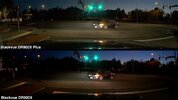I've been running a DR900X Plus for the past week or so and so far I'm really liking it as an upgrade to the DR900X.
As far as video quality is concerned, I am noticing an improvement with the Plus. For testing I've been driving around with the DR900X, DR900X Plus, and U1000.
View attachment 58120
View attachment 58121
Today I'm spending the day going back through sample footage to see the video quality differences. I've only looked through one test so far, but it does look like the DR900X Plus is bringing video quality closer to the U1000 which is what I was hoping for.
View attachment 58119
I've got a bunch more videos to go through, driving day and night.
In a couple weeks I'm gonna be heading to a local installer to do a bunch of upgrades to my car including running new power cables for the DR900S/DR750S now so I can upgrade to the X series. I was also wanting to run cables to install a U1000 next to the DR900X up front because I really really want better video quality than what the DR900X offers. If the DR900X Plus does indeed close the gap with the U1000 and it looks like it very well may, I won't bother running permanent cables for the Thinkware and I can keep my WS clear with more room to keep testing different dashcams.
The bluetooth pairing stuff with the 900X Plus is nice, making it easier to initially pair the dashcam with your phone without having to punch in your default wifi pw. Once you do create the initial pairing though one way or another, it's not a big difference.
I'm really liking the DR900X Plus / CM100LTE allowing for up to 5 devices connected instead of just one. I'm testing with the DR900X Plus serving as a hotspot for another dashcam, two phones, and a RD, and it works fine without issue. I do have to switch the DR900X Plus to 2.4 GHz because Escort's radar detectors only support 2.4 GHz for some dumb reason, haha. Either way, the connection is much more stable than the flaky OBD II hotspot I have hooked up to some battery packs that have been providing parking mode data for my dashcams. I don't like that the CM100LTE is one more thing to unplug every time I wanna pull the memory card out from my DR900X Plus, but I am seriously considering switching over the CM100LTE for in-car WiFi moving forward now that it supports multiple devices.
Anyways, just some initial thoughts. Back to looking through more sample footage.


